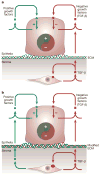Stromal fibroblasts in cancer initiation and progression
- PMID: 15549095
- PMCID: PMC3050735
- DOI: 10.1038/nature03096
Stromal fibroblasts in cancer initiation and progression
Abstract
It is widely accepted that the development of carcinoma--the most common form of human cancer--is due to the accumulation of somatic mutations in epithelial cells. The behaviour of carcinomas is also influenced by the tumour microenvironment, which includes extracellular matrix, blood vasculature, inflammatory cells and fibroblasts. Recent studies reveal that fibroblasts have a more profound influence on the development and progression of carcinomas than was previously appreciated. These new findings have important therapeutic implications.
Figures


References
-
- Lengauer C, Kinzler KW, Vogelstein B. Genetic instabilities in human cancers. Nature. 1998;396:643–9. - PubMed
-
- Ronnov-Jessen L, Petersen OW, Bissell MJ. Cellular changes involved in conversion of normal to malignant breast: importance of the stromal reaction. Physiol Rev. 1996;76:69–125. - PubMed
-
- Tlsty TD, Hein PW. Know thy neighbor: stromal cells can contribute oncogenic signals. Curr Opin Genet Dev. 2001;11:54–9. - PubMed
-
- Carmeliet P, Jain RK. Angiogenesis in cancer and other diseases. Nature. 2000;407:249–57. - PubMed
-
- Sandler AB, Johnson DH, Herbst RS. Anti-vascular endothelial growth factor monoclonals in non-small cell lung cancer. Clin Cancer Res. 2004;10:4258s–4262s. - PubMed
Publication types
MeSH terms
Grants and funding
LinkOut - more resources
Full Text Sources
Other Literature Sources

